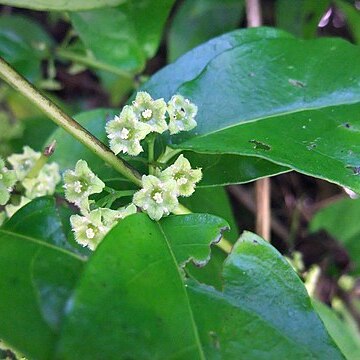Shrubs or small trees. Branchlets subterete, rarely 4-angled, sometimes 4-winged. Leaves opposite, petiolate or rarely sessile; petiole base with a short ocrea; leaf blade margin entire. Inflorescences axillary, sometimes directly from main branches, 1-to many-flowered, cymose, congested or not; bracts scalelike to sepal-like. Flowers 5-merous. Sepals mostly free or nearly so, inside usually with glands at base. Corolla campanulate to rotate, tube thinly fleshy; lobes thick, imbricate or contorted and then overlapping to left in bud. Stamens inserted at corolla mouth, exserted, recurved after anthesis; filaments usually short; anthers suborbicular to narrowly ovate, often with a distinct appendage. Ovary 2-locular, with many ovules per locule. Style often very short; stigma clavate, ellipsoid, or subglobose, ± as large as ovary. Capsules ellipsoid to globose, 2-valved, septicidal or septifragal, many seeded. Seeds brown to black, ellipsoid to subglobose, concave on hilar side, minutely warty, embedded in a juicy yellow to red pulp; embryo small; endosperm papery to starchy.
Small shrubs to small trees, rarely scrambling to semi-climbing. Leaves petiolate or sessile; stipules interpetiolar, sometimes intrapetiolar. Inflorescences terminal (subg. Labordia) or axillary, simple to much-branched cymose; accessory axes may be present. Flowers 5-merous. Calyx connate at base; lobes imbricate. Corolla campanulate to rotate; hairs, when present, in throat, mouth and often on lobes. Stamens inserted in corolla mouth; anthers 2-locular; connective often forming apical appendage. Ovary superior, 2-or 3-locular; ovules numerous; stigma clavate or ellipsoidal to globular. Fruit a capsule, 2-or 3-valved, septicidal, often also subseptifragal. Seeds embedded in fleshy placentas, numerous, ellipsoidal to subglobular.
Fls 5-merous in axillary ± congested cymes. Calyx-lobes acute; corolla campanulate to rotate, us. contorted in bud, lobes spreading when fl. expanded. Stamens affixed at or near throat on short filaments. Ovary 2-loculed, style simple, stigma capitate. Capsule ± globose; valves 2, separating from axis. Seeds ∞, enveloped by persistent placentae. Glab. shrubs, with opp. lvs connected by stipular line. Some 35 spp. of Madagascar, Mauritius, Malaya, New Guinea, Polynesia, Australia. The N.Z. sp. endemic.

